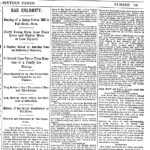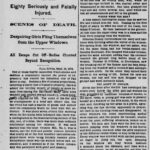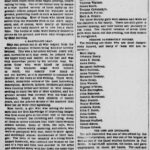On September 19, 1874 a very destructive fire at a mill in Fall River, Massachusetts killed or injured many of the employees. In its October 10, 1874 issue Harper’s Weekly analyzed the fire and highlighted the heroism of a young man (page 835):
THE FALL RIVER DISASTER.
THE full accounts of the burning of the Granite Mill at Fall River, of which we give several illustrations on page 841, show that the means of escape provided were entirely inadequate to the emergency. The mill was a large structure, 328 feet long, 70 feet wide, and six stories in height. Over 330 persons were employed on the premises, of whom 87 were on the fifth and sixth floors and 36 on the fourth floor, where the fire originated in the machinery. The ordinary means of exit were a stone tower in the middle and outside of the building, with a wooden stairway connecting with each floor, and an elevator running from the basement to the upper story. There were besides several fire-escape iron ladders fixed on the walls, and communicating with the floors at the windows. It was doubtless thought that these means were ample, and that had there been no panic all the operatives might have escaped in safety. But there was a panic, as there always must be at such a time, and means of escape can not be considered ample that do not provide for such an emergency. If people threatened by death in one of its most horrible forms could keep cool and collected, they could make use of the means provided for their safety; but as a matter of fact they do not keep cool, they always grow frantic and lose their senses, and this is just what must be provided for. In the case of the Fall River disaster, the flames almost immediately spread to the wooden stairway in the tower and cut off that means of escape. Then the machinery was stopped, and the elevator was rendered useless. There remained only the iron fire escapes. To descend from the top of a lofty building by a perpendicular ladder is not an easy matter for a woman or child at any time; it is preposterous to suppose that they could save themselves in this way with the building filled with blinding, suffocating smoke, the flames bursting through every floor, and every window crowded with frantic people. Panic and confusion were inevitable. Women and children threw themselves from the windows, and were dashed to pieces on the ground. Even the fire-escapes were soon rendered inaccessible by the progress of the flames, and had there been no panic would have been useless. One brave and collected man, JOHN N. BOSWORTH, a sailor, who had just reached Fall River in search of work, rescued two persons from the flames at the risk of his own life. He gained the roof of the mill, made a strong rope fast, and by this means descended to the ground, carrying a woman on his back. Ascending again by climbing the rope, he rescued a boy in the same manner. The progress of the fire prevented another return. He subsequently recovered nine bodies from the still burning mill, venturing in so reckless of his own safety that his clothing several times took fire. We give his portrait from a photograph taken immediately after the disaster.
Both The Chicago Daily Tribune and The New York Herald reported the fire in their September 20th issues. The Herald mentioned Bosworth’s bravery, but the details were different than Harper’s: “The hero of the calamity is a young fellow named Bosworth, who lowered one woman on the end of a rope and then took another in his arms and descended safely with her down the same rope to the ground. A moment later and the flames had burned the upper end of the rope so that it was no longer available.” In its September 21, 1874 issue (page 3) the Worcester Daily Press said “The Truth Worse Than the First Reports.”




